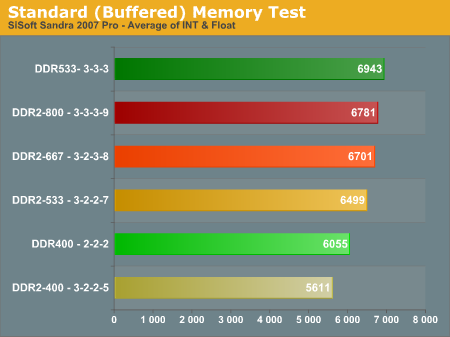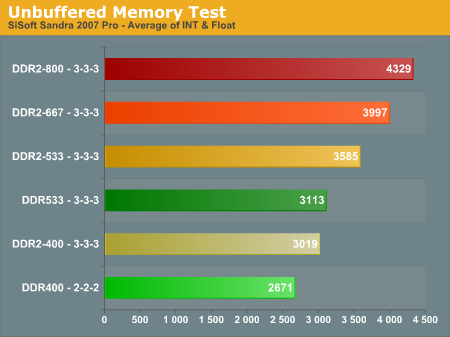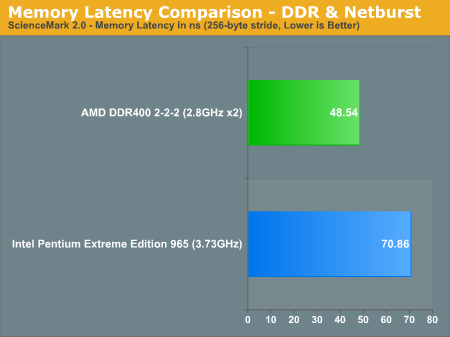DDR/NetBurst Memory Bandwidth and Latency
One of the most talked-about AMD advantages of the last couple of years has been their on-processor memory controller. This has allowed, according to popular theories, the Athlon64 to significantly outperform Intel NetBurst processors. The fact is NetBurst DDR2 bandwidth has recently been similar or wider in bandwidth than Athlon64 - even when the DDR is overclocked. You can see this clearly when we compare Buffered and Unbuffered Bandwidth of a NetBurst 3.46EE to an AMD 4800+ x2(2.4GHz, 2x1MB Cache) running DDR400 2-2-2 and running overclocked memory at DDR533 3-3-3.
The green bars represent DDR memory performance, while the beige to red are increasing DDR2 speed on NetBurst. Light green represents DDR400 2-2-2 while Dark Green is overclocked memory at the same CPU speed, DDR533 at 3-3-3.

In buffered performance, Fast DDR400 is only faster than DDR2-400 and slower than DDR2-533, 667 and 800. Overclocked memory at DDR533 3-3-3 is faster than any of the DDR2 bandwidths on NetBurst.
The Sandra Unbuffered Memory Test, which turns off features that tend to artificially boost performance, is generally a better measure of how memory will behave comparatively in gaming. The same green for DDR applies here.

Without Buffering, DDR400 has the smallest bandwidth of tested memory speeds and timings. Even overclocking to DDR533 allows the DDR to barely beat DDR2-400. DDR2-533, 667, and 800 all have greater Unbuffered bandwidth than the DDR overclocked to 533. NetBurst DDR2 memory bandwidth is generally wider than the bandwidth supplied by DDR memory on Athlon64. Despite the wider bandwidth, the deep pipelines and other inefficiencies in the NetBurst design did not allow the NetBurst processors to outperform Athlon64. Keep this in mind later, when we look at AM2 and Core 2 Duo Memory Bandwidth.
Latency
The other area where AMD has had an advantage over NetBurst DDR2 performance is memory latency, the result of the on-processor memory controller. Comparison of the AMD DDR Memory controller and the Intel DDR2 Memory controller in the Intel chipset shows AMD DDR with latency about 35% lower than Intel NetBurst in Science Mark 2.0.

While memory bandwidth was very similar between AMD and NetBurst, the deep pipes of the NetBurst design still behaved as if they were bandwidth starved. On the other hand the AMD architecture made use of the bandwidth available and the much lower latency to outperform NetBurst across the board.
One of the most talked-about AMD advantages of the last couple of years has been their on-processor memory controller. This has allowed, according to popular theories, the Athlon64 to significantly outperform Intel NetBurst processors. The fact is NetBurst DDR2 bandwidth has recently been similar or wider in bandwidth than Athlon64 - even when the DDR is overclocked. You can see this clearly when we compare Buffered and Unbuffered Bandwidth of a NetBurst 3.46EE to an AMD 4800+ x2(2.4GHz, 2x1MB Cache) running DDR400 2-2-2 and running overclocked memory at DDR533 3-3-3.
The green bars represent DDR memory performance, while the beige to red are increasing DDR2 speed on NetBurst. Light green represents DDR400 2-2-2 while Dark Green is overclocked memory at the same CPU speed, DDR533 at 3-3-3.

In buffered performance, Fast DDR400 is only faster than DDR2-400 and slower than DDR2-533, 667 and 800. Overclocked memory at DDR533 3-3-3 is faster than any of the DDR2 bandwidths on NetBurst.
The Sandra Unbuffered Memory Test, which turns off features that tend to artificially boost performance, is generally a better measure of how memory will behave comparatively in gaming. The same green for DDR applies here.

Without Buffering, DDR400 has the smallest bandwidth of tested memory speeds and timings. Even overclocking to DDR533 allows the DDR to barely beat DDR2-400. DDR2-533, 667, and 800 all have greater Unbuffered bandwidth than the DDR overclocked to 533. NetBurst DDR2 memory bandwidth is generally wider than the bandwidth supplied by DDR memory on Athlon64. Despite the wider bandwidth, the deep pipelines and other inefficiencies in the NetBurst design did not allow the NetBurst processors to outperform Athlon64. Keep this in mind later, when we look at AM2 and Core 2 Duo Memory Bandwidth.
Latency
The other area where AMD has had an advantage over NetBurst DDR2 performance is memory latency, the result of the on-processor memory controller. Comparison of the AMD DDR Memory controller and the Intel DDR2 Memory controller in the Intel chipset shows AMD DDR with latency about 35% lower than Intel NetBurst in Science Mark 2.0.

While memory bandwidth was very similar between AMD and NetBurst, the deep pipes of the NetBurst design still behaved as if they were bandwidth starved. On the other hand the AMD architecture made use of the bandwidth available and the much lower latency to outperform NetBurst across the board.










118 Comments
View All Comments
TonyB - Tuesday, July 25, 2006 - link
so ive been hearing a lot of people use this argument, "oh competition is good, i can get a so-and-so cpu now for xyz price!!". what an incredible value!cant you bring that a notch higher and say, "dang, Intel just whooped AMD, i'm going to purchase an amd K6-2 400mhz cpu now for $5" yes! horray for competition! what an incredible value only $5!
at what point does reality set in that you're investing in obsolete technology? or does the old rationale, "i dont want the fastest, this old crap is good enough for me" still apply.
OcHungry - Wednesday, July 26, 2006 - link
You waited 4 years to say that "crap" about AMD's bargain value? but please dont tell us about your 4 years venture in finding a better way to exhust your P4 hot air.very nice.
Calin - Wednesday, July 26, 2006 - link
Unfortunately, the current production processors don't reach that low a value (the AM2 semprons have a price of around $70+, and the Socket A semprons have a price of around $50). You might want to invest in new obsolete technology (with a longer warranty), or you might want to invest in old obsolete technology (or in old current technology, see refurbs).As long as your performance needs are reached, you could be certain to a degree that a failure in your computer could be repaired/replaced in short time, you are ok to go with Pentium MMX or so processors. Anyway, finding SDR RAM for your K6-2 might not be so easy (and SDR DIMMs were a new memory standard then). Good luck finding enough SIMMs to put the memory at 128MB
BPB - Tuesday, July 25, 2006 - link
How about an article spending $200 on both the CPU and video card ($400 total) and then look at what various motherboard and memory combos get me. You could spend $100 to $250 on motherboards and show me what I get, with memory hopefully being the same for the Intel and AMD systems. That's really the bottom line for myself and many, many others. Many if not most of us set a price range for CPU, video card, and memory and then go from there. Either that or simple overall cost is set. I know you give us buying guides where you spend X amount on systems, but I don't think you show us the power each system gets.photoguy99 - Tuesday, July 25, 2006 - link
They already have those articles - They periodically release CPU and Graphics card guides that analyze the bang for the buck at different budgets.BPB - Tuesday, July 25, 2006 - link
I know they do that, but I don't think I've seen both "here's what $1000 gets for an AMD/Intel system" and "here's how fast each system is". That's what I'd like to see. I know how much individual parts cost and how fast they are in and of themselves, but put it all together and show me systems and compare those systems. If they've done that in the past I've missed it. But the past no longer matters, so I'd love to see one that's current as of today's new prices.Calin - Wednesday, July 26, 2006 - link
The computer price guides did just that - taking a budget of $$$ or $$$$ and building systems. There was the budger guide, gamer guide and "all out" guide (this last one had price ranges at $2000+)bob661 - Tuesday, July 25, 2006 - link
What was the purpose of this article? Was there something that was left out of the tons of earlier benchmarks from various websites?bob661 - Tuesday, July 25, 2006 - link
Thanks guys. I don't remember seeing info about memory either.rjm55 - Tuesday, July 25, 2006 - link
There were a lot of things that I hadn't seen anywhere else. No one I have read shows that Conroe is lower in Bandwidth than either AM2 or Netburst. I find that surprising looking at Conroe's big performance lead. This is also the first time I've seen AM2/Conroe compared clock-to-clock in the same configuration using the same memory/settings - and at 2.93GHz. The new graphs for memory speeds show directions and provide more info that bar charts. Suggest you use them more in other reviews.